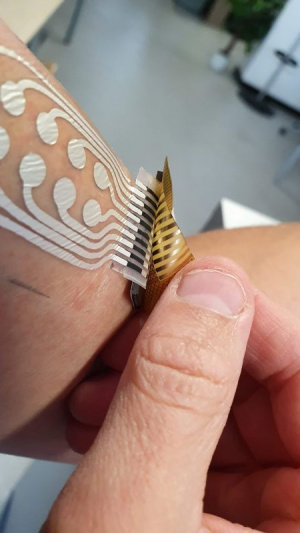Difference between revisions of "Flexible Electronic Systems and Embedded Epidermal Devices"
From iis-projects
(→Flexible Electronic Systems and Embedded Epidermal Devices) |
(→Flexible Electronic Systems and Embedded Epidermal Devices) |
||
| Line 4: | Line 4: | ||
==Flexible Electronic Systems and Embedded Epidermal Devices== | ==Flexible Electronic Systems and Embedded Epidermal Devices== | ||
| − | '''Flexible Electronic Systems''' utilize polymers and other flexible or strechable materials to form wearable and conformable devices. These system are often composed of various flexible, bendable but also small | + | '''Flexible Electronic Systems''' utilize polymers and other flexible or strechable materials to form wearable and conformable devices. These system are often composed of various flexible, bendable but also small ridgid components, such as electrodes, transducers, transistors and complete IC's. These designs allow for '''comfortable wear''', as they can be positioned closely to or even attached to the human body (as epidermal devices). Moreover, the integration of '''digital electronic parts enables''' the devices to '''perform a wide range of functions''', such as continuous monitoring and modulation of physiological signals, or the communication with other devices. |
However, the development of such systems is associated with a number of challenges. These are not only the material properties per se (e.g. flexibility, ductility or biocompatibility), but also their advanced and specialized manufacturing techniques, reliability issues due to bending and mechanical stresses and interface problems at every level of integration. | However, the development of such systems is associated with a number of challenges. These are not only the material properties per se (e.g. flexibility, ductility or biocompatibility), but also their advanced and specialized manufacturing techniques, reliability issues due to bending and mechanical stresses and interface problems at every level of integration. | ||
Revision as of 23:22, 5 February 2023
Contents
Flexible Electronic Systems and Embedded Epidermal Devices
Flexible Electronic Systems utilize polymers and other flexible or strechable materials to form wearable and conformable devices. These system are often composed of various flexible, bendable but also small ridgid components, such as electrodes, transducers, transistors and complete IC's. These designs allow for comfortable wear, as they can be positioned closely to or even attached to the human body (as epidermal devices). Moreover, the integration of digital electronic parts enables the devices to perform a wide range of functions, such as continuous monitoring and modulation of physiological signals, or the communication with other devices.
However, the development of such systems is associated with a number of challenges. These are not only the material properties per se (e.g. flexibility, ductility or biocompatibility), but also their advanced and specialized manufacturing techniques, reliability issues due to bending and mechanical stresses and interface problems at every level of integration.
On the one hand, our research focus aims at interconnectivity and reliability of digital circuits on flexible, stretchable substrates. In this way, we bring hardware intelligence ever closer to the actual skin surface. On the other hand, we develop embedded solutions that enable new manufacturing technologies.
Our Activities
Contact
Christoph Leitner
|
Projects
All projects are annotated with one or more possible project types (M/S/B/G) and a number of students (1 to 3).
- M: Master's thesis: 26 weeks full-time (6 months) for one student only
- S: Semester project: 14 weeks half-time (1 semester lecture period) or 7 weeks full-time for 1-3 students
- B: Bachelor's thesis: 14 weeks half-time (1 semester lecture period) for one student only
- G: Group project: 14 weeks part-time (1 semester lecture period) for 2-3 students
Usually, these are merely suggestions from our side; proposals can often be reformulated to fit students' needs.
Available Projects
- Adaptively Controlled Polarization And Hysteresis Curve Tracing For Polymer Piezoelectrics (1 S/B)
- Development Of A Test Bed For Ultrasonic Transducer Characterization (1 S/B)
- Towards Flexible and Printable Wearables

